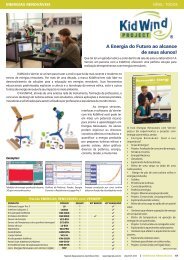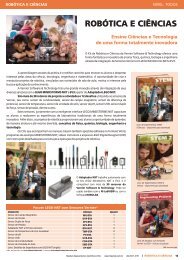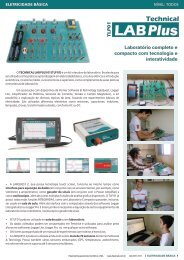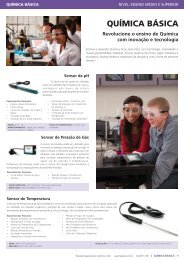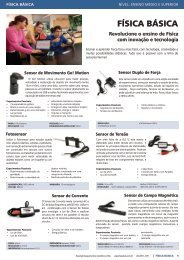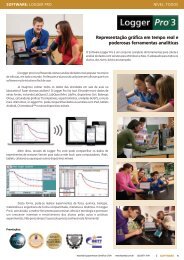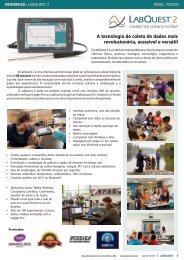Heliocentris - Energias Renováveis
You also want an ePaper? Increase the reach of your titles
YUMPU automatically turns print PDFs into web optimized ePapers that Google loves.
Kennlinie der Brennstoffzelle<br />
Material:<br />
Zerlegbare Brennstoffzelle mit Membran Verbraucher-Messbox<br />
0,3 mg/cm 2 Pt sowie Wasserstoff- und 4 Kabel<br />
Sauerstoffendplatte montiert nach<br />
2 lange Schläuche<br />
Aufbauanleitung<br />
2 kurze Schläuche<br />
2 Schlauchverschlussstopfen<br />
Komponenten aus Schülerkasten<br />
Solar-Wasserstoff-Technologie:<br />
Zusätzliche Komponenten:<br />
Solarmodul<br />
Lampe 100-150 Watt<br />
Elektrolyseur<br />
Destilliertes Wasser<br />
Durchführung:<br />
Beachten Sie die Anweisungen aus der Bedienungsanleitung!<br />
Beim Experimentieren Schutzbrille tragen und Zündquellen fernhalten!!!<br />
Bild z1a (Spülen):<br />
Verbraucher-Messbox<br />
Solarmodul<br />
A V R<br />
Lampe<br />
+ + - -<br />
+ -<br />
+ -<br />
0 ml ml 0<br />
2<br />
2<br />
4<br />
4<br />
6<br />
6<br />
8<br />
8<br />
O 2 H<br />
10<br />
10<br />
2<br />
O2 H2<br />
Elektrolyseur<br />
Brennstoffzelle<br />
© Copyright 2002 heliocentris<br />
Interpretation/Hinweise:<br />
1<br />
0,9<br />
0,8<br />
0,7<br />
0,6<br />
0,5<br />
0,4<br />
0,3<br />
0,2<br />
0,1<br />
0<br />
300<br />
250<br />
200<br />
150<br />
100<br />
50<br />
Kenlinie als Funktion der Katalysatorbelegung<br />
Katalysator 0,1 mg<br />
Katalysator 0,3 mg<br />
0 100 200 300 400 500<br />
Strom in mA<br />
Leistung als Funktion der Katalysatorbelegung<br />
Katalysator 0,1 mg<br />
Katalysator 0,3 mg<br />
0<br />
0 100 200 300 400 500<br />
Strom in mA<br />
Die Interpretation der Ergebnisse ist zusammenfassend in Anleitung z6 beschrieben.<br />
© Copyright 2002 heliocentris<br />
FARADAY- und Energiewirkungsgrad<br />
der<br />
Brennstoffzelle<br />
Material:<br />
Zerlegbare Brennstoffzelle mit Membran Verbraucher-Messbox<br />
0,3 mg/cm 2 Pt sowie Wasserstoff- und Stoppuhr<br />
Sauerstoffendplatte montiert nach<br />
4 Kabel<br />
Aufbauanleitung<br />
2 lange Schläuche<br />
2 kurze Schläuche<br />
Komponenten aus Schülerkasten<br />
2 Schlauchverschlussstopfen<br />
Solar-Wasserstoff-Technologie:<br />
Solarmodul<br />
Zusätzliche Komponenten:<br />
Elektrolyseur<br />
Lampe 100-150 Watt<br />
Destilliertes Wasser<br />
Durchführung:<br />
Beachten Sie die Anweisungen aus der Bedienungsanleitung!<br />
Beim Experimentieren Schutzbrille tragen und Zündquellen fernhalten!!!<br />
Bild z2a (Spülen):<br />
Verbraucher-Messbox<br />
Solarmodul<br />
A V R<br />
Science Kit<br />
Lampe<br />
Science Kit<br />
+ + - -<br />
ACADEMIA OFFERING<br />
+ -<br />
+ -<br />
0 ml ml 0<br />
2<br />
2<br />
4<br />
4<br />
6<br />
6<br />
8<br />
8<br />
O 2 H<br />
10<br />
10<br />
2<br />
Science Kit<br />
O2 H2<br />
Elektrolyseur<br />
Brennstoffzelle<br />
© Copyright 2002 heliocentris<br />
06.13/JT | Printed in Germany<br />
Science Kit<br />
Practice and Demonstration Set for Solar Hydrogen Technology<br />
The Science Kit is an extensive experiment set for the<br />
subject of renewable energies. 20 pre-configured<br />
experiments and accompanying materials make it a<br />
complete solution for physics and chemistry lessons.<br />
Includes<br />
Instructional<br />
Materials<br />
School Level<br />
The components form a complete solar-hydrogen energy conversion<br />
chain and can be flexibly combined with one another. The topic of<br />
renewable energies can be approached in consideration of the entire<br />
conversion chain or on the level of the individual technologies, such<br />
as photovoltaics or fuel cells. All components can be used and investigated<br />
separately.<br />
Key Features<br />
»»<br />
Basic design of fuel cells and solar cells<br />
»»<br />
Up to 5 students can work with the Science Kit at the same time<br />
»»<br />
Suitable for communicating subject matter from physics, chemistry<br />
Components<br />
and technology curricula<br />
»»<br />
Energy Storage and use of renewable energies<br />
»»<br />
Chemical reactions of the entire energy conversion chain, e.g. water<br />
to hydrogen and oxygen or methanol to carbon dioxide and current<br />
»»<br />
Hydrogen generation by means of electrolysis via solar module or<br />
hand generator<br />
»»<br />
Conversion of solar energy to electronic energy and hydrogen<br />
»»<br />
Calculating the efficiency of fuel cells<br />
»»<br />
Use of stored energy<br />
»»<br />
Separation of water into hydrogen and oxygen<br />
Fuel cell<br />
Load measurement<br />
box<br />
Methanol fuel cell*<br />
E z2<br />
A tention: Use and replication of the image data is only permitted with written approval by LECHUZA, write to pr@lechuza.com |<br />
Storage box<br />
FUEL CELL COMPONENTS*<br />
Instruction material with Experiment Guide<br />
and CD<br />
Sample Experiments<br />
»»<br />
Examination of solar cells and their efficiency<br />
»»<br />
How to determine the tilt angle of solar cells<br />
»»<br />
How many solar cells supply a house?<br />
»»<br />
Investigation of water electrolysis –<br />
how is water separated?<br />
»»<br />
Investigation of the electrolyzer: Does current increase<br />
when the voltage is increased?<br />
»»<br />
Examination of a hydrogen and methanol fuel cell<br />
»»<br />
How does the green house effect work?<br />
»»<br />
Examination of efficiency in the system<br />
»»<br />
Investigating electrolyzers and fuel cells<br />
»»<br />
Hydrogen as an energy carrier and storage<br />
»»<br />
How to create a characteristic curve of an electrolyzer<br />
and of a hydrogen and methanol fuel cell<br />
»»<br />
Calculating the Faraday efficiency of an electrolyzer<br />
E z1<br />
Spannung in V<br />
Leistung in mW<br />
Product Options<br />
Science Kit Complete<br />
Basic experiments and in-depth<br />
experiments for various fuel cell types<br />
»»<br />
Electrolyzer<br />
»»<br />
Fuel cell<br />
»»<br />
Solar panel<br />
»»<br />
Load measurement box<br />
»»<br />
Instruction material with Experiment<br />
Guide + CD<br />
»»<br />
Take-apart fuel cell*<br />
»»<br />
Methanol fuel cell*<br />
Accessories<br />
Science Kit Demo<br />
A variety of basic experiments for<br />
physics, chemistry or technology<br />
lessons<br />
»»<br />
Electrolyzer<br />
»»<br />
Fuel cell<br />
»»<br />
Solar panel<br />
»»<br />
Load measurement box<br />
»»<br />
Instruction material with Experiment Guide + CD<br />
Art. no. 355 Art. no. 350<br />
Lamp Double spotlight for simulating sunlight Art. no. 314<br />
Dimensions (W x H x D): 430 x 150 x 310 mm, weight: approx. 5.6 kg.<br />
*Only included with Science Kit Complete.<br />
Science Kit<br />
is available as<br />
a class set.<br />
Page 7<br />
Science Kit<br />
5





